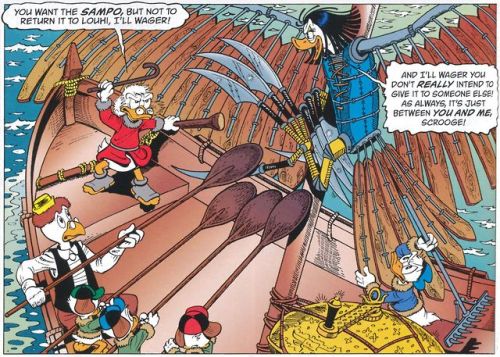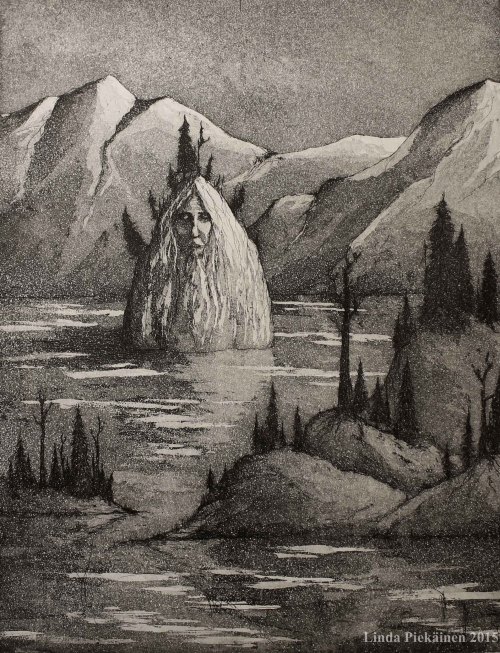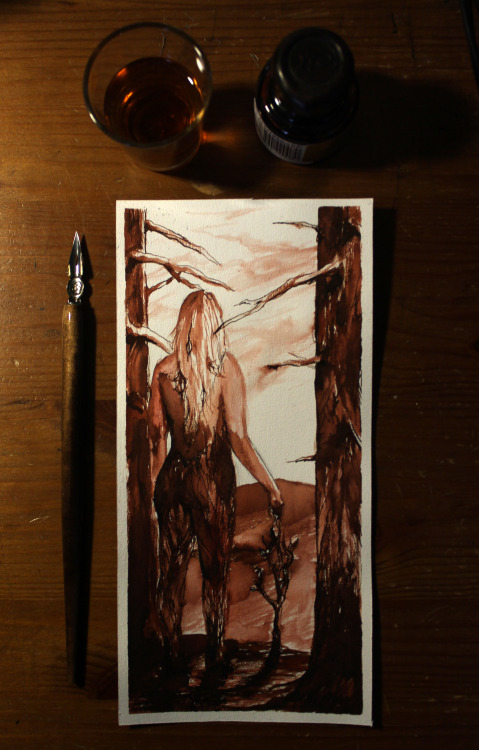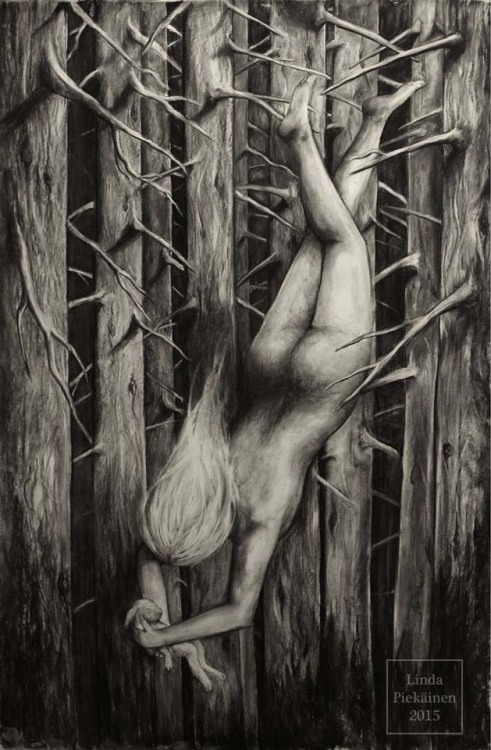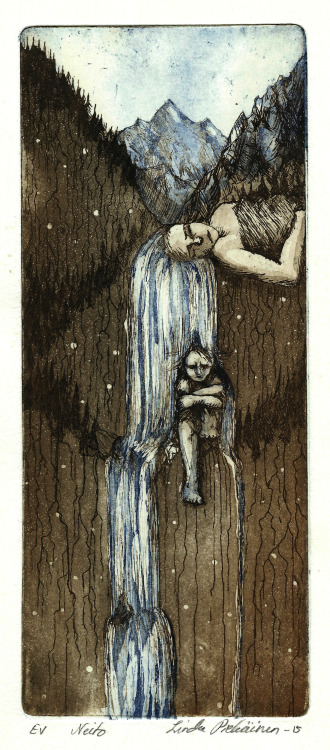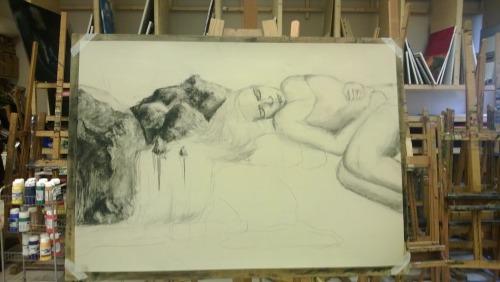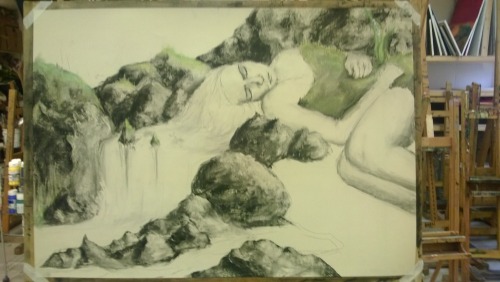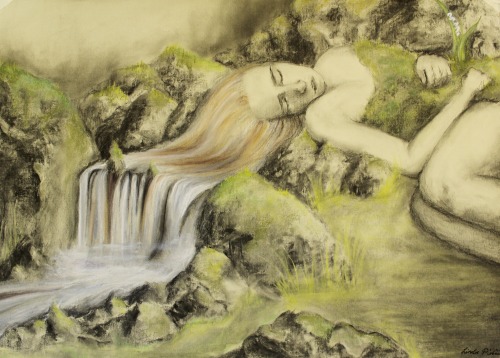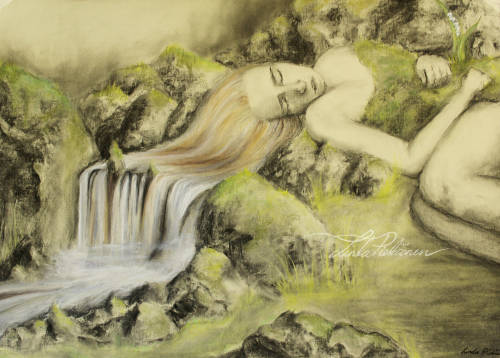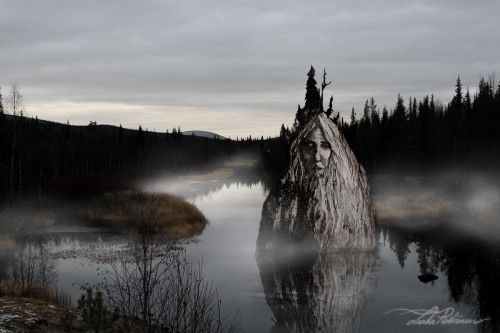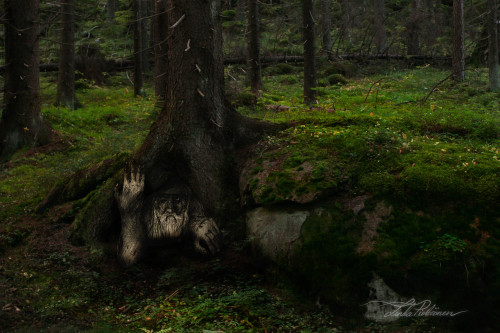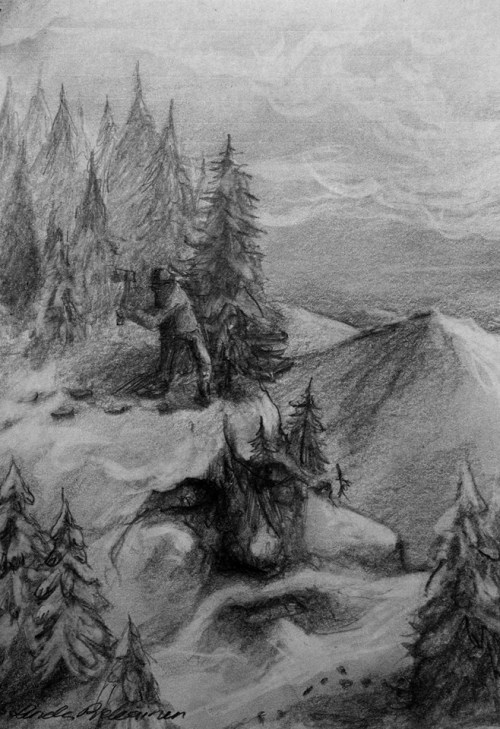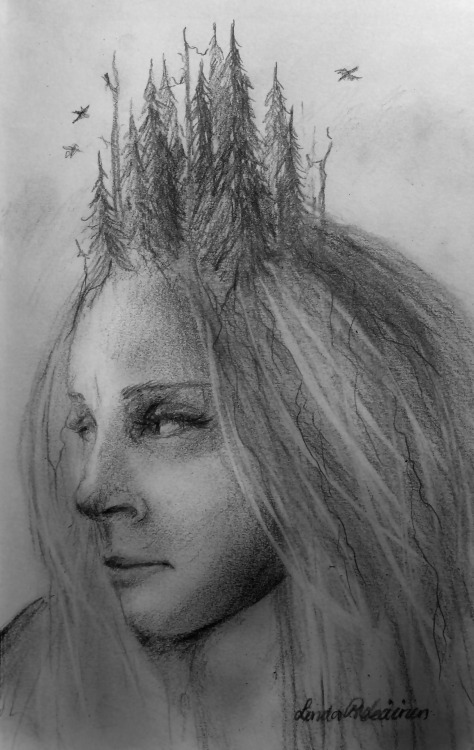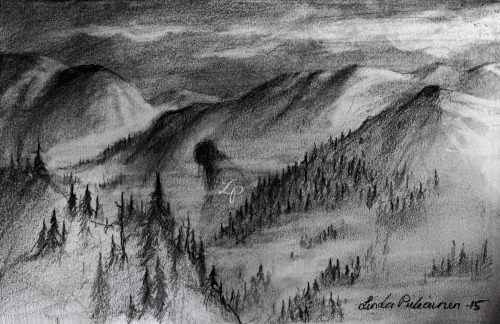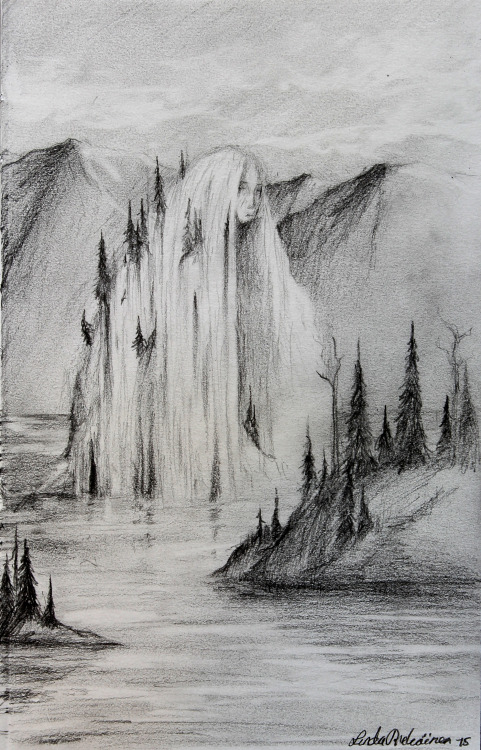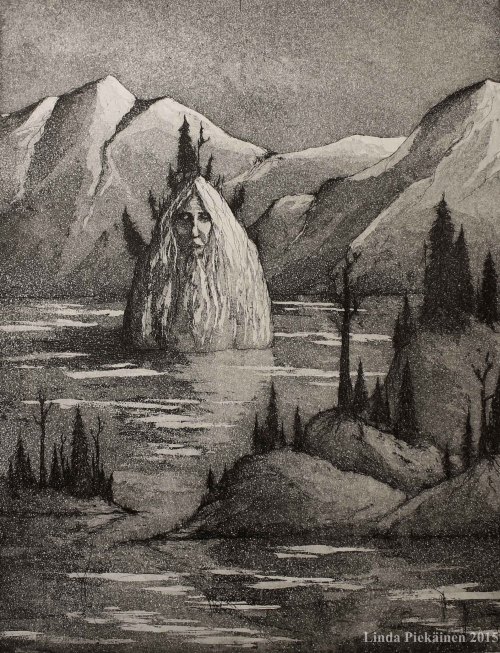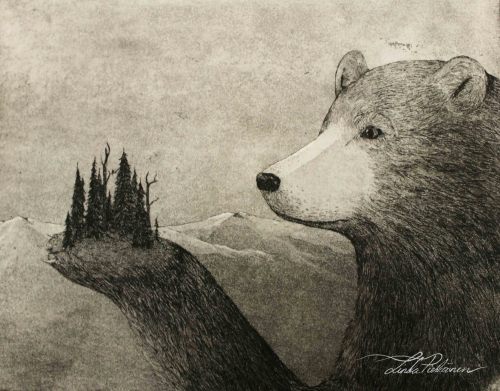#kalevala
In his Uncle Scrooge story arc set around the legends of the Kalevala and Finland, Don Rosa recreated the famous painting, “the Defense of the Sampo.”
Post link
We don’t always have a lot of information about ancient myth and how it survived. Even when stories were relatively well-documented, as in the case of Greece and Rome, you can’t always tell where they came from or how they evolved into the form we know now. And when the tales were written down by people who did not see them as religious? That adds a whole additional layer of intention to see through.
The Scandinavian and the insular Celtic myths that we know were written down long ago, generally by people who were at best dispassionate and at worst antagonistic toward the beliefs those stories reflected. The tales in the Elder (Poetic) Edda were copied down by Christian monks–how much in them is an accurate transcription of what they knew or heard? (That said, how much did the stories change among those who believed during the pre-literate centuries?) In the Younger (Prose) Edda, Snorri’s intent was primarily the preservation of a literary form rather than its content, which provides a different set of difficulties. In both cases, however, the conversion had been recent enough that a certain amount of the Norse myth was maintained. The Celts were not quite so fortunate, and the Irish legends (and especially the Welsh ones) can be difficult to parse for religious content. The stories, however, are often still there.
In the Kalevala we have a comparatively modern (and comparatively well-documented) instance of surviving ancient tales making their way into the modern record.
The Finns of the time (like their Scandinavian neighbors) had not been pagan since the 12th century BCE or so. and by the mid-19th century any myths in their original form or forms had long disappeared. What still existed, however, was a long-standing tradition of story-singing in which one could hear echoes of the ancient Finnish pagan faith. This oral tradition existed for centuries, but by the 19th century the practice was dying out, and with it what was known of ancient myth.
We can thank Elias Lönnrott for the survival of much of what we know about Finnish folklore and myth, as he was the author of the Kalevala, the Finnish national epic poem. The 19th century in Europe was a time of political upheaval, of smaller and less powerful lands reacting to many years of having been occupied by larger and more aggressive nations; in the case of the Finns, the occupier was Russia (they did not declare their independence until 1917). One way in which the smaller lands, such as Hungary and Poland as well as Finland, asserted their identity was through their native folklore and myth. The Kalevala was an example of this–a reminder to Finns of their unique culture.
Lönnrott travelled far and wide throughout Finland, going from place to place, listening to the story-singers and writing down their tales. This research took years and resulted in a large body of work and a wide variety of songs (including many stories with more than one version depending on the region and the storyteller). It was an impressive feat and one which resulted in the survival of many stories and lore that otherwise would have been long lost.
With reference to Lönnrott I use the word “author” mindfully and with intent, because in assembling his poem he used enough poetic license that the work as a whole can be considered his creation. He sometimes combined characters (the Kalevala’s version of Lemminkainen, for example, includes characteristics of several other heroes as well), renamed them or created them out of whole cloth to be featured in existing tales (such as the unfortunate bride Aino, who is never named such in in the original songs).
This isn’t intended as a criticism of Lönnrott, by the way; while saving the stories was one of his goals, it was not the only one–and the creation of the Kalevala, Finland’s national epic poem, was itself a uniting force. What the Kalevala is not, however, is an accurate retelling of ancient Finnish myth or of the folktales that held its last remnants.
However, the wonderful thing about the Finnish stories is that we don’t only have Lönnrott’s final work to rely on. We also have his extensive records and transcriptions of the songs and stories he tracked down so long ago. We know much of what, in the Kalevala, is Lönnrott’s own work; we can tell when he changed things. We have the original 19th-century songs and you can actually go in and compare different versions of the same stories.
I absolutely recommend reading the Kalevala or any of the transcribed Finnish songs. The stories are wonderful, and the rhythm of the poetry is beautiful and unique.
References:
Kuusi, Matti, Ed. Trans. Keith Bosley. A Trail for Singers: Finnish Folk Poetry: Epic Finnish Literature Society: Helsinki, 1999.
Lönnrott, Elias. Trans. Keith Bosley. The Kalevala. Oxford University Press: London, 2009. Kindle edition.
Pentikäinen, Juha Y., Trans. Ritva Poom. Kalevala Mythology. 2nd ed. Indiana University Press: Bloomington, 1999.
By popular demand (haha what a joke there was no demand for this post, it’s just a dream of mine to some day use that phrase) here’s a list of the characters of Kalevala, organised by place of residence. This time also provided to you in alphabetical order because well, only the best for my readers. Oh and there’s also a list of the cows of Kalevala. Enjoy!
Kalevala / Karjala / Väinölä
Aino∞sister to Joukahainen, betrothed to Väinämöinen but instead of marrying him she drowns herself and become’s a Vellamon neiti, maiden of water
Ainikki∞sister to Lemminkäinen
Annikki∞sister to Ilmarinen
Ilmarinen∞a skilled smith who forges the Sampo, marries Pohjan neiti and after losing her forges the silver bride and later the lights of sky
Joukahainen∞skinny boy from Lapland who loses to Väinämöinen in poem singing and promises his sister Aino toVäinämöinen just to spare his own life
Kalervo∞father of Kullervo, brother to Untamo
Kalervon impi∞mother of Kullervo,Kalervo’s wife
Kullervo∞a youngling raised in slavery, seduces his own sister by accident (she kills herself after realising this), takes revenge on Untamo, loses his parents and ends up taking his own life
Kyllikki/Kylli∞a beautiful maiden, stolen by Lemminkäinen to be his wife, she agrees to be married to Lemminkäinen but eventually breaks her vows
Lemminkäinen/Ahti Saarelainen/Kauko∞a warrior, ladies man, quarrelsome, but also a skilled noita, a witch, who has a tight bond with his mother
Lemminkäisen äiti∞mother of Lemminkäinen, a renown healer, who repeatedly tries to stop her son from his often too daring endeavours
Lokka /Kalevatar∞mother ofIlmarinen
Marjatta∞a fair maiden who gets impregnated from eating a lingonberry, gives birth to a son; the boy goes lost but she manages to find him with help from taivaanvalot, lights of the sky
Marjatan poika/Karjalan kuningas∞son of Marjatta, whom Väinämöinen wants to condemn to death, but who then starts to speak of Väinämöinen’s past sins and is then known as the king of Karjala (he is a symbol for Christianity)
Ruotus/Sarajas&Ruotuksen emäntä∞owners of the house from where Marjatta seeks help for her birth (Ruotus is derived from biblical Herodes)
Tiera/Kuura∞“friend” of Lemminkäinen during the war to Pohjola
Untamo/Unto∞brother of Kalervo, who is told to have killed Kalervo and his family, only keeping Kullervo as his slave; he sells KullervotoIlmarinen but eventually ends up being killed by Kullervo
Väinämöinen/Väinö/Suvantolainen∞old wise man, a shaman, who has his part in the creation of the world, makes trips to the realm of the dead, invents the kantele; has poor luck with women, children and stealing the Sampo, but his kantele playing has the ability to charm every being present
Pohjola / Sariola
Louhi/Pohjan akka/Ilpotar∞the ruler of Pohjola, a fierce noita, a witch, she has the power to transform into the eagle Kokko; she has daughters who the men from Kalevala often come to ask for marriage
Märkähattu∞a blind old shepherd, whom Lemminkäinen accuses of incest and bestiality and who then kills Lemminkäinen
Pohjolan tyttäret∞the daughters of Louhi, amount unclear, probably 3
Louhen tytär /Ilmarin emäntä∞daughter of Louhi, wanted among many Kalevalan men, ends up being married to Ilmarinen after he forges the Sampo; she is killed by Kullervo after which Ilmarinen goes to ask for another of Louhi’s daughters to marry
Pohjan neito∞a girl who lived in Pohjola whomVäinämöinentried to lure to be his wife, most likely one of Louhi’s daughters
Pohjolan isäntä∞lord of Pohjola, a skilled spellweaver who ends up getting killed by Lemmnikäinen
Ukko uunin päällä∞a gaffer living in Pohjola who recites the birth words of ale, gives words of advice to a husband-to-be and helps Väinämöinen to cure a wound
Tuonela
Antero Vipunen/Untamo∞a shaman who holds great knowledge and has passed to the realm of the dead
Loviatar∞she gave birth to the worst of diseases
Tuonen akka,ukko&poika∞the lady, lord and son of the realm of the dead who weave a web of iron and cast it to the river of Tuonela to stop Väinämöinen from leaving their lands
Tuonen tytti/Tuonen neito∞daughter of Tuoni who does laundry by the shores of the river of Tuonela (see also Kiputyttö)
Tuonetar∞the matron of Tuonela
Tuoni∞personified death, ruler of Tuonela
Deities
Aallotar∞a female spirit of water
Ahto/Veden isäntä∞king of waves, ruler of the realm of waters; known as other folklore asAhti
Akka aaltojen alainen∞a female haltija, guardian spirit, of rapids (see also Kosken tyttö)
Akka manteren alainen/Mannun eukko∞goddess of earth; appears in spell-poems
Etelätär/Suvetar∞a female haltija of springtime; appears especially in spells of protecting cattle
Hiisi/Juutas, Juuttaat∞mythical evil being, a synonym for bad things; also meant a place, usually a bad and probably dangerous place
Hiiden hevonen ∞ Hiisi’s horse; appears in spell-poems
Hiiden hirvi ∞ Hiisi’s mythical moose who Lemminkäinen sets to hunt
Hongatar∞goddess spirit
Humala/Remusen poika∞personified hop (humulus lupulus)
Iku-Turso∞a terrifying sea monster who Louhi conjures out of the waves, but whom Väinämöinen speaks over to fall back into the depths
Ilman impi/Ilmatar∞the oldest air spirit, she is the mother ofVäinämöinen
Kaleva/Osmo∞the mythical ancestor of all people of Kalevala
Kalevatar∞helper of creating beer
Kalma/Surma∞personification of death (the act of dying itself, not same as Tuoni)
Katajatar∞goddess spirit
Kave eukko∞mythical nature spirit, appears in spell-poems
Kiputyttö/Kivutar/Vammatar∞appears in healing spell-poems
Kivi-Kimmo,Kammon poika∞guardian spirit of rocks, who Lemminkäinen asks to set aside the foam of water from the way of boatmen
Kosken tyttö/Kuohuneiti/Neiti kosken-korvallinen∞guardian spirit of rapids
Kuuhut∞personified moon
Kuutar/Otavatar/Päivätär/Tähetär∞goddess spirit of fabric weaving and moonlight
Lempo∞a being(?) associated with Hiisi and other evil things; often used as an insulting word
Luonnottaret∞nature goddesses; three of them gave birth to iron, three gave birth to snakes
Melatar∞a spirit associated with rowing
Metsän piika∞a forest spirit (see also Tapion neiti)
Mielikki/Mimerkki∞matron goddess of forest
Nyyrikki∞son of Tapio, who grants luck in hunting- and herding spells
Osmotar/Kapo kaljojen tekijä∞guardian spirit of ale, gives advice to a bride
Otsonen∞godly figure of forest; appears in bear-hunting spell-poems
Pihlajatar∞goddess spirit
Päivä/Päivyt/Tähti∞personified natural force
Päivän poika∞son of the Sun, releases a spark of fire from the stomach of a pike
Sampsa Pellervoinen∞mythical character; appears in poems about fields, cultivation and cutting down trees
Siniviitta∞a mythical forest spirit, who tells Kullervo in the woods that his family is alive, contrary to what Kullervo had believed (see also Ajattaret)
Sotkottaret∞water maidens of a kind, who inhabit the shores and are filled with awe by the sound of Väinämöinen’s kantele playing
Suonetar∞a goddess spirit; appears in healing (stitching a wound, mending broken bones, surgical operations) poems
Syöjätär∞a spirit who had to do with the birth of snakes
Tapio∞ruler and god of forest
Tapion neiti∞a female spirit residing in the forest
Tellervo∞possibly wife to Tapio, goddess spirit of the forest, protector of cattle in forest
Terhenetär/Uutar/Udutar∞guardian spirit of mist and fog
Tuometar∞goddess spirit
Tursas∞a being who rose from the waters to grant the perfect soil for the first oak to grow on
Tuulikki∞daughter of Tapio, goddess spirit of forest
Ukko∞the high god, commander of weather
Veden emäntä/Vellamo∞goddess of water
Veen emonen ∞ Ilmatar after she descended from the skies and laid on the water
Cows
What? You’re not into cows? Well too bad, I’m listing them anyway!
Hermikki ∞ Ilmarinen’s cow
Kimmo ∞ a cow
Kyyttä ∞ Ilmarinen’s cow
Mairikki ∞ Ilmarinen’s cow
Mansikkinen ∞ Lemminkäinen’s cow
Muurikki ∞ a cow
Muurikkinen ∞ Lemminkäinen’s cow
Omena ∞ Ilmarinen’s cow
Pienikki ∞ Ilmarinen’s cow
Puolukka ∞ Lemminkäinen’s cow
Tuorikki ∞ Ilmarinen’s cow
During its time of existing, the Kalevala has been interpreted many times, in various ways, and quite often from a male view. Even though the main characters in the Kalevala are men, there is also an abundance of strong and amazing female characters presented in the national epic. My favourite character when I was growing up was Louhi, the powerful sorceress and ruler of Pohjola. To me she represents strength, a kind of and unyielding and cunning mind. Louhi is a fierce leader, but she still holds her daughters so dear to her that she makes the men who ask them for marriage really work for it.
And it’s not just Louhi who should be celebrated as the woman who protected her land from men who wanted to steal the Sampo, there is not a single female in Kalevala who shouldn’t be celebrated. May it be said that the world of Kalevala itself was created by a woman, and with that, I’ll let you find your own feminist icon among the women of Kalevala.
Aino
Aino’s brother, Joukahainen, goes against Väinämöinen, the old wise man, and loses. Väinämöinen sings him into a swamp and Joukahainen keeps drowning deeper and deeper. When he’s neck deep in the muddy water he promises his young, beautiful sister Aino to be Väinämöinen’s wife. Väinämöinen agrees to this and so lets Joukahainen keep his life. He returns home to give the news and breaks to tears, being ashamed of what he’s done.
Their mother is overjoyed by this; a great man such as Väinämöinen is sure to bring the family riches and raise their status. But Aino is not pleased. Väinämöinen is old and she is not yet ready to marry, she wants to be free and wander in the woods, not cook and clean after a man. Her mother suppresses her resistance to the marriage and only sees how grand a wedding they will soon have, without realising the agony her of her daughter.
One day after Aino had met with Väinämöinen in the woods, felt his looks, hungry and desiring, on her body she decides to run away from it all. She puts on the wedding dress her mother has laid out for her, weaves ribbons in her hair and just runs. For two whole days Aino travels aimlessly, contemplating on her life and whether anyone would really care if she exists or not. “Mother might cry a little, father probably wouldn’t, brother would hardly notice” she thinks to herself. Her brother had sold her off just like that, only to keep his own sorry life, her mother pushed her to be married without giving any thought to how Aino felt about it. Eventually Aino comes to the shore of the ocean where she sits down and just waits for a night.
In the morning mist over the water Aino sees young maidens, dancing and bathing with their hair running free and she longs to be just like them. She takes off her wedding dress and starts to swim towards a rock, gleaming golden in the sunlight. When she reaches the rock and sets foot on it, it suddenly sinks into the waves and takes Aino with it.
Mother of Aino
A forest rabbit brings the news of Aino’s drowning to her mother. Tears of remorse fill her eyes. Only now, after she has lost her daughter she realises how wrong she did, pushing her daughter like that. She only wanted Väinämöinen for his name, for his fame, for her own sake without understanding Aino’s needs and desires.
“Do not force your young daughters, do not decide for them. Do not raise your children only to fulfil your own wishes”, she warns other parents as her tears keep flowing. They flow so long and so strong that three rivers are born of them and the sorrow that fills the mother’s heart ages her before her time. She sees her fault and wrong doing when it’s already too late, but she is able to admit it and grow from her mistakes. She knows she can’t get her daughter back but maybe she can help some other young maiden by telling their parents of her mistakes.
Aino’s brother Joukahainen doesn’t see his own blame in Aino’s destiny, but sets to kill Väinämöinen, blaming the man for Aino’s death. The mother tries to stop this; no good will come out of another death, it won’t bring Aino back. But Joukahainen doesn’t listen and shoots Väinämöinen’s horse and sees the great wise man fall to the ocean. What he doesn’t know is that Väinämöinen didn’t drown, maybe by the help of Aino’s mother’s prayers?
Kyllikki
Kyllikki is the daughter of a wealthy family, known among many men for her beauty and for the amount of suitors she’s turned down. Kyllikki is strong in her belief that one day she will find the man of her dreams, someone stable and caring to come and ask for her hand and so she keeps turning down everyone who she thinks is unable to meet her high expectations.
Among her suitors is Lemminkäinen, a poor fisher and a ladies man, who sees Kyllikki as a challenge and sets to put his charms to the test. Alas, out of all the women in the town only Kyllikki isn’t seduced by his good looks and sweet talk. His man-ego hurting after being turned down, Lemminkäinen steals Kyllikki to be his wife, who of course is reluctant at first, but eventually she accepts her fate. She agrees to be wife to Lemminkäinen in one condition; Lemminkäinen must never start fights or go to battles. He agrees and sets his one condition to Kyllikki; she must never go to village dances and festivals. She agrees.
Time goes by, Kyllikki learns to love her husband and they both hold onto their promises. Lemminkäinen goes to the sea for fishing and stays on his way for a few days longer than he should for his catch is so huge that it requires celebration. Back at home Kyllikki awaits days for him to come back, but grows bored of just sitting around and decides to go out to a dance. When Lemminkäinen comes back and hears from his sister Ainikki that Kyllikki has broken her vow he grows mad.
Lemminkäinen starts to find a war that he could join; Kyllikki broke her vow so he’s going to do the same just for the sake of revenge. Kyllikki tries to hold him from going, his mother tells him to drink a pint of ale and calm down, but Lemminkäinen doesn’t listen. To him, now that Kyllikki has done as she pleased and not what he wanted, she is no longer the challenge he conquered. His man-ego has once again been hurt. Off to Pohjola he goes, that’s a good place to start a good fight. He leaves his comb to his mother and wife, telling them that once it turns bloody he’s been hurt.
So is Kyllikki left behind to wait for his husband who has gone to the dark lands of Pohjola to find a better wife, to ask for Louhi’s daughter to marry. She broke her promise, yes, but is this really the fate she deserves after having sacrificed so much for Lemminkäinen?
Mother of Lemminkäinen
“Now I’ve lost a husband!” cries Kyllikki, and when Lemminkäinen’s mother sees the blood dripping from the comb her son left she too falls to her knees to mourn her loss. But it doesn’t take her long until she wipes away the tears and leaves after her son to Pohjola, for she is determined to find out what fate has met her dear son.
She ran all the way to Pohjola, where Louhi, the ruler of the dark realm did her best to avoid the mother’s inquiries of Lemminkäinen’s fate. Eventually Louhi does tell her how she was displeased that a married man would ask her daughter to marry and how she then set Lemminkäinen to hunt the moose of Hiisi, tame the golden horse and shoot the swan fromthe river ofTuonela. It was the last task from where the man hadn’t come back. Hopeful that her son might still be alive, the mother sets to find him. For a week she searches before hearing from the sun that Lemminkäinen lays in pieces in the bottom of the river of Tuonela.
With a powerful spell, the mother puts to sleep the whole realm of Tuonela and goes to the river. Ilmarinen has forged her a rake of iron, with which she fishes every last piece of her son from the nasty river. She is relentless in finishing her task, she puts together the pieces of Lemminkäinen like a puzzle by the riverbank and with spells and incantations she weaves her son back together until the only thing missing from the body is the breath of life. She asks a bee to fly all the way to Heaven and get honey from God’s storage and with this salve Lemminkäinen finally comes back to life.
His mother takes him back to their home, where Kyllikki still waits for her husband.
Louhi
Louhi is not gentle, nor is she kind, but she is fierce and strong and the cold and dark lands which she rules have taught her in many ways. She is resourceful, cunning, used to hardship and to overcoming bad times. Behind her back, Louhi is dubbed as the harlot of Pohjola, blind matron, sparse tooth and the dark woman.
After Väinämöinen’s horse was shot by Joukahainen, he himself was left drifting on the waters until he came to at the shores of Pohjola, Louhi’s kingdom. Louhi takes in the weary traveller and tells that she will take the man safely back to his own land, but only after Väinämöinen has promised her the Sampo; a mythical machine that will create wealth itself. Väinämöinen tells Louhi that he himself is not skilled enough to make the Sampo, but the smith Ilmarinen might very well be able to make such a machine although he might not be willing to make it without a proper price. Louhi promises the smith one of her daughters to marry and with that, Väinämöinen leaves Pohjola only to come back later with Ilmarinen who indeed is able to forge the Sampo.
But Louhi deceives the men of Kalevala; she has no intention whatsoever to force any of her daughters to marry, even less so when the girls themselves don’t want to. To Louhi the only thing that matters is the well being of her people and family, she’s only glad to cast Ilmarinen out of Pohjola. She would use any means necessary to achieve her goals and she really doesn’t take shit from anyone. Louhi makes her daughters’ suitors go through hellish tasks in order to prove their worth and even if they would succeed, she might still cross them.
Annikki
One bright morning when Annikki, the sister of Ilmarinen, is in the middle of washing clothes by the shore she spots a stranger coming closer on a boat. Who else is it but the old wise Väinämöinen, going who knows where. Annikki asks him where he’s headed but the man wont give her the truth. He says he’s off to fishing, but there are no nets nor hooks and line in the boat. He says he’s going to hunt birds, off to war, but Annikki is not so easy to fool. “Come sit next to me, sweet young lady, and I’ll tell you the truth” Väinämöinen tries to sweet talk Annikki but she doesn’t yield. Quite the contrary; she threatens to turn the whole boat upside down if the man doesn’t spill the truth immediately.
Annikki hears that Väinämöinen is yet again off to Pohjola to ask for Louhi’s daughter to marry. She’s infuriated by this, Louhi’s daughter was promised to her brother Ilmarinen for the Sampo and the woman had turned Ilmarinen down! This wasn’t right! She hurried to tell her brother of Väinämöinen’s plans.
Ilmarinen is at first reluctant to go and ask for Louhi’s daughter’s hand again, but after bathing in the sauna he’s a whole new man. Annikki sees that her brother is dressed accordingly, wishes him well and shoos him on his way. Her righteousness pushed Ilmarinen to pursue the woman he had wanted to marry.
Louhen tytär / Ilmarisen emäntä
Louhi’s daughter hasn’t been able to get Ilmarinen out of her head since her mother turned him down after the making of the Sampo. Her mind is infested with the thought that maybe she has made a terrible mistake in not marrying him, maybe the smith could have been the man of her dreams?
So when Väinämöinen and Ilmarinen one day show up at the gates of Pohjola to both ask for her hand in marriage it’s clear who she would rather have her. Louhi is not too happy about her daughter’s choice, like Aino’s mother Louhi too thinks Väinämöinen is the better choice out of the two; he has fame and is a skilled shaman and a warrior. But her daughter is set on Ilmarinen.
Louhi’s daughter does everything she can to help Ilmarinen pass the tests Louhi sets for him. Ilmarinen passes them all and Louhi can’t do but set up their wedding and as hard as it is for Louhi to give her beautiful daughter away to the smith she lets her go anyway; she has her happily-everafter ahead of her.
That happily-everafter only doesn’t last too long for the daughter. Ilmarinen buys a slave, Kullervo, fromUntamo, his previous owner. One day when the youngling goes out to shepherd, Ilmarinen’s wife has baked a stone inside his bread and when Kullervo’s knife breaks upon hitting the rock he conjures the wild beasts of the forest to rip the woman apart before he flees.
Louhi’s daughter got the man she wanted and died because she insulted her husband’s slave. In the poems she is described to have baked the stone in Kullervo’s bread out of malice, with the intention of hurting the youngling. Maybe there was more of her mother’s blood in her veins after all, although the love between her and Ilmarinen must have been great and true for Ilmarinen is clearly left with a void in him after his wife dies. He asks Louhi for another of her daughters to marry, but Louhi declines his requests. In his agony Ilmarinen forges a maiden of gold and silver to replace his late wife. But this golden bride is cold to the touch, stiff and lifeless.
Pohjan neiti
On his journey homewards from Pohjola, having been rejected by yet another woman Väinämöinen sees the fair maiden of Pohjola and being the man he is, tries to entice her to be his wife. But Pohjan neiti is not so easy to lure, she tells Väinämöinen that it was only the other day when she had had a conversation about the subject of marriage with a thrush. “Marriage is a shackle” the thrush had chirruped “a married woman is a slave to her husband, and when has a slave ever been loved by their master?”
It’s time for Väinämöinen’s man-ego to take a hit; he rises from his sleigh and commands the maiden to come to his house and be his wife. “Only after marriage can a girl be a woman!” he storms. Pohjan neito goes Louhi and gives Väinämöinen task after task to fulfil before she can make her decision of whether this is a worthy suitor. After the old man has succeeded in three tasks Pohjan neito challenges Väinämöinen to build a boat without using his hands or his feet. Väinämöinen is full of himself; he knows he’s the best boat builder in the world and his knowledge of words and spell chanting is beyond compare. So lost he is in his thoughts that the ax he has chanted to do his work slips, hits a rock, bounds off of it into his knee and falls on his toe.
Blood oozing from his knee, Väinämöinen takes off on his sleigh and leaves the maiden behind. She doesn’t even raise an eyebrow to help the man.
Marjatta
Virgin maiden Marjatta, shepherding in the woods sits down on the forest bed. So it happens that she picks a single lingonberry and becomes pregnant of it unknowingly. Soon her clothes don’t fit her and she does her best to cover up her pregnancy from her parents.
After ten months when Marjatta feels that the baby is about to be born, her own mother throws her out of the house, calling her impure and disgusting. Her father too casts her aside, even though Marjatta feels that her son is to be a great man and tries her best to explain what had happened to her, that she had not laid with a man but just ate a lingonberry in the woods.
Soon the whole town is against her, no one is willing to let such a woman give birth in their sauna, so she ends up giving birth in the stables. Not long after the baby boy has been born he already goes missing, and Marjatta in her anguish seeks him for a whole week before finally finding her son at the swamp. She takes him home and they start seeking for someone to baptise the baby, but no one is willing to baptise a baby who doesn’t have a father, so they call for Väinämöinen to see into the matter, to decide over the two-week-old child’s faith.
Väinämöinen is cruel in his words, he says the boy should be drowned in the swamp from where he came from. But the baby boy starts to speak of the wise old man’s past sins. He tells of Aino’s drowning, of how Väinämöinen himself doesn’t really have a father. And so the boy is baptised the king of Karjala and Väinämöinen leaves, filled with anger and remorse. The great shaman sails away on his boat, leaving behind his kantele, saying that he will return again when the land needs him.
Marjatta, the symbol of Virgin Mary in the last poem of the Finnish national epic, was without a doubt just as much of an iconic woman as Mary. An outcast and a pariah, celebrated only when her son was realised to be a great man. The whole 50th poem is but a symbolic story about the adopting of Christianity as the common religion and of waving farewell to the old, pagan ways. Yet I wanted to introduce Marjatta here as well for after all, she is a woman of Kalevala.
Ilmatar
The world is young, there is only air and sea and the ever-present gods. The daughter of air, Ilmatar, is bored of her life sailing the skies and descends onto the waters. A tearaway burst of wind dances Ilmatar wildly on the foam topped waves and she becomes pregnant.
The pregnancy takes long, far too long, and after nine years, when her stomach is rock hard and her pain unbearable Ilmatar calls for the high god Ukko to release her of this torment. But no help comes to her aid, only a stray duck flies over the waters and mistaking Ilmatar’s knee for an island stays on top of it. The duck makes its nest and lays seven eggs; six golden and one of iron. For three days the duck incubates the eggs until the heat of it is too much for Ilmatar; she shakes her knee and the eggs fall and break. One after another the shells shatter to pieces that form the sun, the moon, the stars and the clouds on the sky.
Ilmatar still swims in the ocean, floating on her back and her stomach, on her left side and right side, stretching her arms and legs. Where her fingers point are capes formed and where her feet touch the bottom of the ocean become deep basins. Along her sides stack shores of sand, salmon catches form against her feet, gulfs circle her head, rivers come to be of her hair. Islets, islands and rocks rise out of the water around her. The world is created by a woman.
Thirty years after Ilmatar has made this all, the anguish of her pregnancy comes to an end. The child she has been carrying in her womb is Väinämöinen, the first man, and he crawls out of his mother’s womb to see daylight in the world Ilmatar has created for him and for all the people to come.
The women of Kalevala can still teach us some brilliant life lessons today and there are many things we can learn from them. Be it Louhi’s stark nature or Annikki’s sense of justice, Aino’s delicacy or Kyllikki’s self-sacrifice for the sake of making her own happiness, I think the women of Kalevala are quite an amazing bunch.
This blog post was majorly inspired by Riikka Juvonen’s book Louhen hymy (2013) and if you can find it in your local library, I warmly encourage you to read it! If not for the stories, at least take a look at the beautiful illustrations!


Had some fun with this Louhi character design ;)
In Finnish, Northern lights are called “Lights of the Fox”. It comes from the old beliefs, that says the lights come from the fox tail hitting the snow.
by Linda Piekäinen -> her art page on Facebook
Post link
Mielikki, is the finnish female forest spirit or goddess. She is the wife of Tapio and she takes care of the woods and the animals living in it. Hunters used to beg good hunting luck from Mielikki. Also the ones who want to pick up berries and mushroom should ask for her permission.
180cm x 120cm, Charcoal by Linda Piekäinen
Post link
They say in the Nordic mythology you need to thank the Forest before you go hunt or cut down a tree. You wouldn’t like to wake up this Jötunn.
Post link
This is a Finnish symbol for the God of the weather, harvest and thunder, his name is Ukko. The symbol has several names; Ukonvaaja,UkonkirvesandUkonvasara. The translation in english is the Axe of Ukko.
Many people mistake this to be Mjölner (Thor’s hammer), even most of the Finns call this symbol Thor’s hammer when they see it. I want to spread the knowledge, so that more people would notice that the old beliefs in Scandinavia are completely different from the ones in Finland. They have similarities, but we both have our own traditions, mythologies and creatures.
Post link
Vellamo, she is the water goddess in the Finnish old mythology. She’s the one who creates the waves in the seas, and brought the good sailing weather.
by Linda Piekäinen (Link on art page Facebook)
Post link
Art about the nature, old tales and mythologies from the North, by a Finnish artist Linda Piekäinen.
Post link
I’ve been working on a big project amongs some other big projects but boy oh boy is this one beginning to get real exciting!
Here you can see a witchdoctor and her ceremonial headdress. I’ve always been interested in feathers and the shapes and layers they create.
Had a lot of fun painting a troll too!
Follow us in twitter! : www.twitter.com/IronDangerWorld
Pay us a visit at : www.facebook.com/irondangeruniverse/
Post link
PEASANTS SINGING THE OLD RUNOS
A Summer Tour in Finland (1908) Paul Waineman.
Brothers Poavila and Triihvo Jamanen reciting traditional Finnish folk poetry in the village of Uhtua (Kalevala), present-day Republic of Karelia, Russia, 1894.
Veljekset Poavila ja Triihvo Jamanen runoavat Uhtuan kylässä nykyisen Karjalan tasavallan alueella.
Post link

